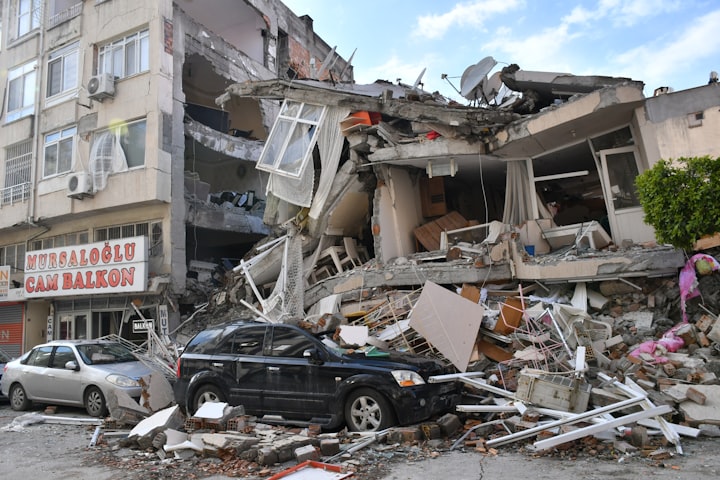Earthquakes in Turkey
Turkey destroyed

Turkey is located in an area where several tectonic plates converge, making it prone to earthquakes. Over the years, Turkey has experienced numerous earthquakes, some of which have caused significant damage and loss of life.
In recent years, there have been several earthquakes in Turkey, including:
The 2011 Van earthquake: A magnitude 7.2 earthquake struck the city of Van in eastern Turkey, killing more than 600 people and injuring thousands.
The 2019 Elazig earthquake: A magnitude 6.8 earthquake struck the eastern province of Elazig, killing 41 people and injuring more than 1,500.
The 2020 Izmir earthquake: A magnitude 7.0 earthquake struck the western city of Izmir, killing more than 100 people and injuring more than 1,000.
These earthquakes have highlighted the importance of preparedness and building structures that can withstand seismic activity. The Turkish government has implemented several measures to improve earthquake resilience, including updating building codes, conducting regular earthquake drills, and developing early warning systems. However, there is still much work to be done to ensure the safety of Turkish citizens in the face of seismic activity.
An earthquake is a sudden shaking of the Earth's surface caused by the release of energy in the Earth's lithosphere (the rigid outermost layer). This energy is released when rocks break along a fault, which is a boundary between two plates in the Earth's crust. Earthquakes can range from barely noticeable to catastrophic and can cause a wide range of damage to structures and infrastructure.
There are several different types of earthquakes, including:
Tectonic earthquakes: These are the most common type of earthquake and occur when the Earth's tectonic plates move past each other, causing stress and pressure to build up and eventually be released in the form of an earthquake.
Volcanic earthquakes: These occur near active volcanoes and are caused by the movement of magma underground.
Collapse earthquakes: These occur when underground caverns or tunnels collapse, causing the ground to shake.
Explosion earthquakes: These occur when explosives are detonated underground, such as during mining operations or military exercises.
Earthquakes are measured using seismometers, which detect and record the vibrations caused by the earthquake. The magnitude of an earthquake is a measure of the amount of energy released during the earthquake, and is typically reported on the Richter scale or the moment magnitude scale.
Earthquakes can cause a range of damage, from minor cracks in buildings to complete destruction of structures and infrastructure. They can also trigger other natural disasters, such as landslides, tsunamis, and volcanic eruptions. It is important for people living in earthquake-prone areas to be prepared and have an emergency plan in place.
Earthquakes
Are very dangerous disasters
However, earthquakes are not uncommon in Turkey as it is located in a region where several tectonic plates meet, including the African Plate, the Arabian Plate, and the Eurasian Plate. These plates are in constant motion, which makes Turkey prone to seismic activity and earthquakes.
It is important for people living in earthquake-prone areas to be prepared for earthquakes by knowing what to do during an earthquake, having an emergency plan in place, and having emergency supplies readily available. The Turkish government and local authorities also take measures to mitigate the impact of earthquakes, including implementing building codes, conducting earthquake drills, and establishing emergency response plans.
Earthquakes occur frequently around the world due to the movement of tectonic plates. Some notable earthquakes that have occurred in recent history include:
The 2010 Haiti earthquake: This earthquake occurred on January 12, 2010, and was a magnitude 7.0 earthquake. It caused widespread destruction and loss of life, with estimates of up to 316,000 deaths.
The 2011 Tohoku earthquake and tsunami: This earthquake occurred on March 11, 2011, off the coast of Japan and was a magnitude 9.0 earthquake. It triggered a devastating tsunami that caused widespread destruction and loss of life, including nearly 16,000 deaths.
The 2015 Nepal earthquake: This earthquake occurred on April 25, 2015, and was a magnitude 7.8 earthquake. It caused widespread damage and loss of life in Nepal, with estimates of over 8,000 deaths.
The 2017 Puebla earthquake: This earthquake occurred on September 19, 2017, and was a magnitude 7.1 earthquake that struck Mexico. It caused significant damage and loss of life, with over 300 people killed.
The 2021 Fukushima earthquake: This earthquake occurred on February 13, 2021, and was a magnitude 7.1 earthquake that struck off the coast of Japan. It caused some damage but did not result in any significant loss of life.
It is important to remember that earthquakes can occur at any time and in any location around the world. It is important for individuals and communities to be prepared for earthquakes by having an emergency plan in place, being aware of potential hazards in their area, and taking steps to mitigate the impact of earthquakes.





Comments
There are no comments for this story
Be the first to respond and start the conversation.